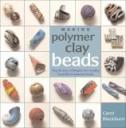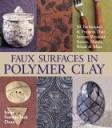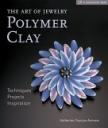
Making Polymer Clay Beads: Step-by-Step Techniques for Creating Beautiful Ornamental Beads
by Carol Blackburn
It’s amazing how much info can be stuffed into a book. This book begins with sections on materials, equipment and workspace, conditioning and baking,making and measureing snakes, strings and sheets, color mixing. Then the beadmaking part begins. At the top of each page are examples of beads using the techniques and shapes discussed on that page. Some topics covered in this section include: drilling, sanding, polishing and varnishing, molding, caning, extrusions, foils, powders and glitters, texturing, transfers, and mokume gane. These are not detailed instructions or projects but overviews of the techniques with limited instructions.
Next is a section on faux techniques including: veined marble, leather, amber, coral, bronze and silver, and an amazing realistic onyx. The last section is about using the beads in jewelry. It discusses findings and thread, attaching findings, and basic design. next is a 10 page gallery with artists names, title of work and small explanations of techniques used. There’s tons of pictures all through this book.
I find this book to be a good reference book. I did learn a few new things but mostly it’s a reminder of things I knew. I did see some bead shapes I don’t normally use that I think I may try. The veined marble is an interesting technique I’d not seen before, though after seeing my first try at it, next time I’ll grind the clay in the coffee grinder instead of chopping it by hand. It’s also quite a bit of work sanding the excess paint away even though I plan to toss them in the tumbler for the remaining grits.








